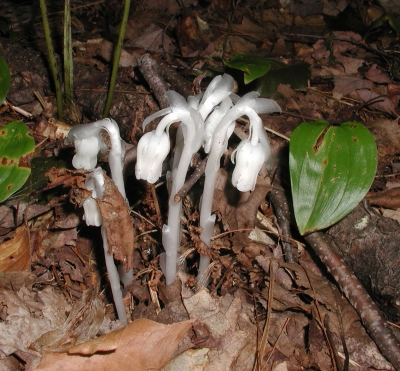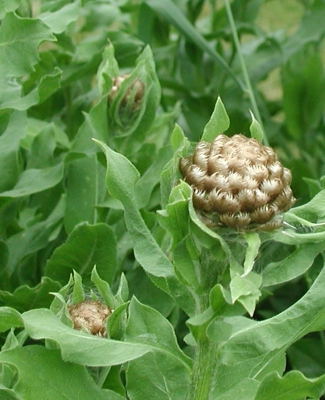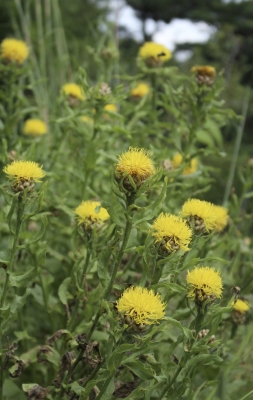Eerie White to Golden Flowers, with Some Fungi Helping Out
White Indian pipes, mycorrhizae, and a golden flower
I do occasionally tear myself away from the farmden. So into the woods I went last Friday and as I was hiking along and glancing down at the trail, I came upon one of my favorite flowers. It’s a favorite not for its beauty but for what it hints at of goings-on beneath the soil surface.
The flower was indian pipes, Monotropa uniflora, an eerily white plant that looks like a upright tobacco pipe whose stem has been poked into the ground. Yes, it’s white. All white. You might rightly wonder how the plant synthesizes carbohydrates for energy and for structure. Photosynthesis, which makes carbohydrates, requires chlorophyll, which is green. Indian pipes don’t need chlorophyll because they get their carbohydrates from neighboring trees.
Join me while I go below ground. Stopping for a look at the roots of indian pipes, we see that they are infected with the fine threads of fungal hyphae. Now, if we follow the fine threads of the fungal hyphae out of the roots and through the soil, we eventually come to the roots of a nearby tree whose roots also are infected by one and the same fungus. A continuous connection exists from the tree to the fungus to the indian pipes.
The tree does have green leaves and, as with other plants, some of the products of its photosynthetic labors are channeled down to its its roots. Some of those products travel out the roots and into the fungal hyphae, and some of that is drawn out of the hyphae into the indian pipes for the latter’s sustenance and growth. Sounds like a one-sided relationship, a pretty good deal for the indian pipes. It is. The plant is a parasite, taking but offering nothing in return.
The relationship between the fungus and the tree, however, is symbiotic and called mycorrhizae (my-co-RYE-zay, which means fungus-root). Yes, the fungus sucks up some of the tree’s photosynthates, but in return it sucks up nutrients from the soil, then channels them back to the tree’s roots. The network of fungal hyphae in the soil is much more extensive than that of the roots, so, with fungal hyphae as “extenders,” the effective volume of soil “grazed” by roots is increased. Mycorrhizae are especially important for uptake of nutrients such as phosphorus, which roots (or their fungal extenders) must go out and find because it moves but little in the soil.
Myco . . . say what?
Wouldn’t mycorrhizae spur growth of garden plants? Yes. But look out your window; most of the plants you see are naturally mycorrhizal already. Still, deliberate inoculation might benefit young transplants. You can purchase inoculum, but the problem is that purchased inoculum often is not of fungal species best adapted to a particular location.
A better approach would be to keep your indigenous fungi happy. Limit tillage, which discombobulates the hyphae, grow a variety of plants, especially those that form mycorrhizal associations, and avoid pesticides. Also limit phosphorus fertilizers because they suppress mycorrhizae.
Another approach would be to grow your own mycorrhizal inoculant of local fungal species. Basically, you mix up a big batch of potting soil that has some indigenous soil in it and is not too high in nutrients. In this potting soil you grow a suitable host plant. (Not spinach, beets, or any plant in the cabbage family, none of which ever form mycorrhizae.) After the host plant dies at the end of the season, what’s left in the pot is indigenous fungal inoculum that can be added to a potting soil for growing seedlings. For more details, see http://rodaleinstitute.org/a-complete-how-to-on-farm-am-fungus-inoculum-production/. I use garden soil and compost in my potting mixes and assume there’s sufficient inoculum already present.
Grow Some Gold
As I rounded the bend at the back of my garden after my woodland hike, I came face to face with a flower I had planted temporarily back there, giant knapweed (Centaurea macrocephala), also known as Armenian basket flower, globe centaurea, and yellow hardhat. Plants with too many common names are usually suspect to me, and none of this plant’s names have a particularly nice ring to them — yet this plant is a showstopper.
From the whorl of rather coarse leaves at the base of the plant rises a sturdy flower stalk. At almost 4 feet high, a big fat bud forms atop the stalk, a bud that looks like a globe artichoke that has been gilded. Nice enough even then, but a couple of weeks later — which is now — a bottlebrush of lemon yellow petals spills forth from the top of the bud.
Globe centaurea, the name most euphonious to my ears, tolerates heat and cold (USDA Hardiness Zones 3 to 8), and is relatively carefree. No need to prop the flower stalk up with a stake. The blossoms put on their show for about a month, not counting the gilded opening act, and hold up well as cut flowers, or can be dried.
 Globe centaurea deserves more attention over much of the country, except perhaps in the Pacific Northwest, where it’s considered invasive. I grew it years ago, and it disappeared. Nice to have it back.
Globe centaurea deserves more attention over much of the country, except perhaps in the Pacific Northwest, where it’s considered invasive. I grew it years ago, and it disappeared. Nice to have it back.



hi lee,
wonderful post. i recently saw indian pipe as well. question, i planted two hardy kiwi last year and have them growing up a trellis. have not pruned them. they have a few laterals. should i cut them back now, or wait until dormant?
alan gorkin
Depending n where you are, it may or may not be a bit late to prune anything. If you still have months of warm weather and the laterals originate below the height of the eventual cordon, cut them off. If cold starts settling in by the end of September and the laterals originate off the developing trunk, cut them off next spring. If laterals originate high up, leave them for next years fruiting arms.
Indian Pipes (as well as other parasitic or hemiparasitic plants) DO offer something in return – they’re supporting greater biodiversity. If they reduce the vigor of a dominant species, niches open for other, less vigorous species. The decomposition of the flower stalks provide a source of nutrients for other forest floor plants and also encourage more diverse soil life. There have been reports of bears eating them and the flowers provide a nectar source for bees.